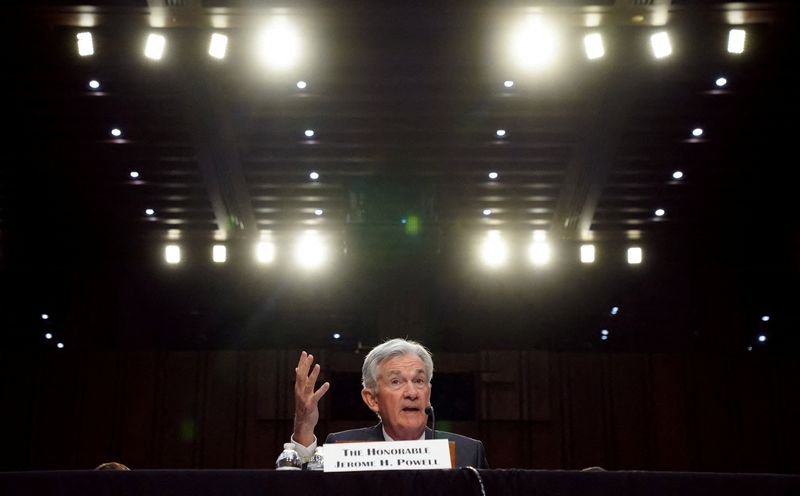By Jamie McGeever
ORLANDO, Florida (Reuters) -The U.S. Federal Reserve looks set to go full throttle again with its interest rate drive, leaving other central banks in a dilemma over whether to follow slavishly or risk another dollar surge.
The history books suggest the latter.
The Fed's peers have been unwilling or unable to match the full extent of U.S. tightening cycles in the past, and many are once again signaling they will stop short of the Fed this time around too.
Fed Chair Jerome Powell's congressional testimony on Tuesday was remarkable, not so much for what he said - most people expected him to talk tough - but in the reaction it unleashed.
The peak Fed rate implied by U.S. rates futures jumped to 5.70%, the two-year Treasury yield leapt above 5% for the first time since 2007, and the 2s/10s yield curve inverted by more than 100 basis points for the first time since 1981.
Rates traders now reckon a 50 basis point rate hike later this month is three times more likely than a quarter point increase, economists at Goldman Sachs (NYSE:GS) raised their terminal rate forecast to 5.50-5.75%, and analysts at BlackRock (NYSE:BLK) said there's a "reasonable chance" the Fed goes to 6%.
It was perhaps coincidental, but no less symbolic, that Powell's remarks came the same day the Reserve Bank of Australia signaled its rate-hiking campaign will end soon.
Bank of England Governor Andrew Bailey has said the central bank may be at the end of its rate-rising cycle, there's a wide 'hawk-dove' divide within the European Central Bank, and the Bank of Canada on Wednesday became the first major central bank to pause its tightening campaign.
"I don't think other major central banks are going to be able to match what the Fed is going to do. And you will see that in the currency markets," said Bill Callahan, investment strategist at Schroders (LON:SDR). "The dollar can stay elevated as long as the Fed remains the most aggressive central bank in the world."
The dollar on Tuesday had its best day since November against a basket of major currencies, gaining most on the Aussie dollar. It also rose significantly against the euro, despite the recent hawkish repricing of the ECB outlook too.
ONE STEP BEYOND
A look into the last six U.S. monetary tightening cycles, including the current one, shows that the ECB (and Germany's Bundesbank before it), BoE and Bank of Japan have rarely raised rates as much as the Fed.
The exceptions were the 1999-2000 cycle, where the ECB raised rates a bit more to try and arrest the euro's post-launch collapse, and the BoE in the mid-1980s as it fought to slay high inflation and prop up a weak pound.
Other than that, the Fed has always led the way. In some cycles other central banks have not raised rates at all - the BOJ has kept rates near zero for the last 30 years, and the Bundesbank actually went against the Fed in the 1980s and 1990s and cut rates.
This has almost always widened the two-year U.S. yield spread over comparable German, UK and Japanese bonds - in some cases by more than 300 bps - but the dollar has not always benefited.
The dollar index slumped in 1986-89, and lost around 10% over the 1994-95 hiking cycle and the Greenspan Fed's 'measured pace' procession of 2004-06. It rose more than 15% in 1999-2000, and as much as 20% last year.
To quote former Fed chief Alan Greenspan's famous view on FX rates, the dollar's direction this year may well be a coin toss, given how much it has already appreciated.
"The dollar should be supported while Fed expectations adjust higher and risks remain skewed to the upside for the front end of the U.S. curve ... (but) the dollar is trading significantly rich to our estimate of its long-term fair value," BNP Paribas (EPA:BNPP) wrote in a note on Tuesday.
Of course, central bank cycles don't always converge. Myriad domestic economic, policy, political and market dynamics are at play at any particular time, forcing policymakers into action independent of global factors and the Fed.
There are structural reasons why other central banks don't match the Fed's rate increases. Stronger U.S. economic growth often warrants higher U.S. rates, Japan has been battling deflation for over 20 years, and the ECB may have quietly preferred an exporter-friendly weaker exchange rate.
In addition U.S. rate-hiking cycles can overlap with central bank FX intervention. This happened in the mid-1980s with the Plaza and Louvre Accords, ECB-led action to support the euro in 2000, and rare yen-buying intervention from the BOJ last year.
But when monetary tightening is broadly synchronized, the Fed almost always goes further.
(The opinions expressed here are those of the author, a columnist for Reuters.)
Related columns:
- Hedge funds record wager on higher 2-year U.S. bond yield

- Rates market overshoot - or no man's land?
- Faced down by Fed, markets dab 6% onto risk radar
(By Jamie McGeever; Editing by Andrea Ricci)